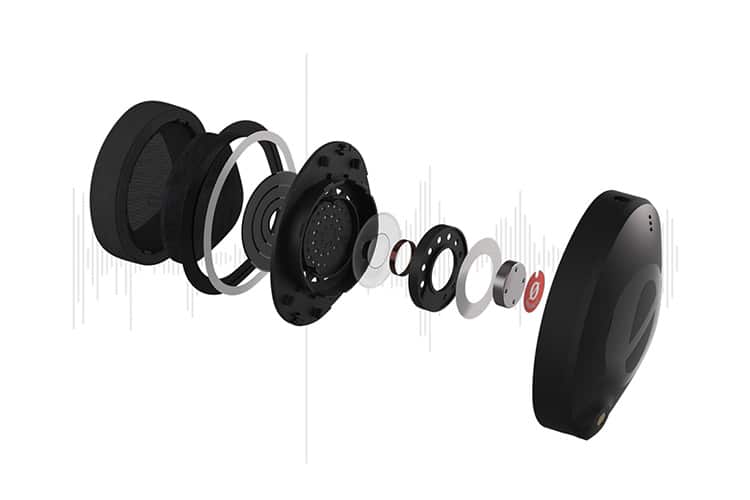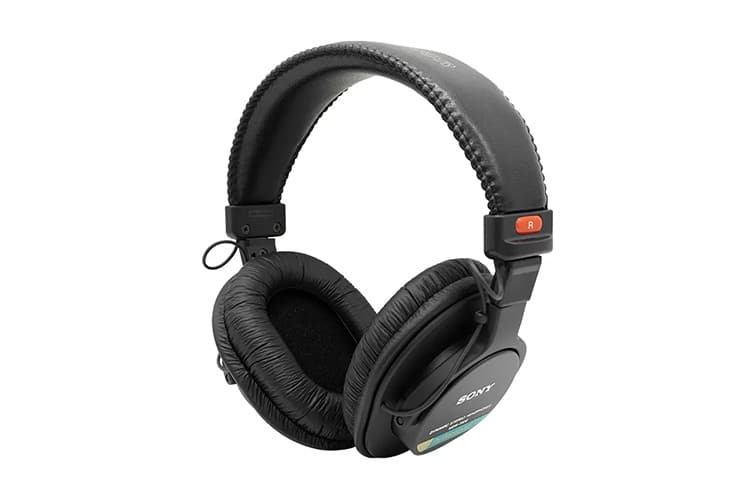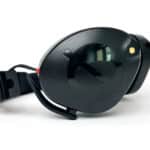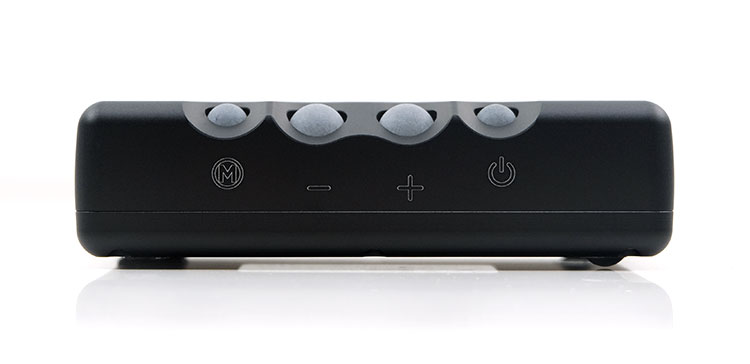This is an in-depth review of the Rode NTH-100 which is a closed-back customized dynamic driver headphone with a FitLok™️ locking system. It is priced at $149.
Disclaimer: This is a purchased or owned unit and not sent by the company. Headfonics is an independent website with no affiliate links or status. You can read up on Rode in more detail on their company website.
You can click here to learn more about dynamic driver headphones we have previously featured on Headfonics.
Note, that this article follows our latest scoring guidelines which you can read up on here.
Today, we review the first closed full-size monitors from an Australian brand of recording equipment called Rode.
The NTH-100 is positioned as a universal solution for working with sound, so we will take a closer look at its capabilities and compare it with models similar in design.
The company was founded back in 1967 by Henry Freedman and Peter Freedman. The brand is headquartered in Sydney, Australia.
The company is best known for its microphones and recorders for both professional audio recording and consumer use, including smartphone users.
The brand has been in recording equipment for a very long time; however, this is their first attempt in recent years to conquer the full-sized headphones market, and we have to find out how successful it is.

Tech Highlights
The Rode NTH-100 is equipped with dynamic 40mm drivers. The drivers are tuned for the most detailed sound picture, considering they need to work inside closed headphone bowls.
The main focus in the development of headphones was placed on comfort during prolonged use, sound detail, optimal ergonomics, and robust design. Also, Rode specialists pay a lot of attention to sound insulation – the manufacturer claims up to -20dB of passive sound insulation.
Design
The NTH-100 are compact over-ear headphones with a metal headband. They look minimalistic, professional, and stylish at the same time.
The NTH-100 metal headband and the quality of the materials promise to give maximum durability – everything is assembled and fitted well, and no backlash and squeaks were noticed during usage. The only design problem is that the cable that runs from the ear cups to the headband is not protected enough, which means it is quite vulnerable.
The bowls are located on separate legs, and therefore quite flexible in terms of adjustment to the user. The position of the headband is fixed with two twist locks. The ear pads are not removable and can be difficult to replace and clean. Made from soft velour-like material. Feels good on the skin and does not cause discomfort.
Each cup has a glossy embossed brand logo. From a practical point of view, this is a very controversial decision, since the gloss will quickly lose its original appearance.
On the other hand, such a decision looks aesthetic. Moreover, the NTH-100 bowls are small metal inserts of gold color, they have no practical purpose, so this is just a decorative element.
Stock Cable
The NTH-100 2.4m stock cable is made of quality thick rubber. At one end of the wire, there is a 3.5mm jack with a twist lock, and at the other end, there is a 3.5mm jack with a screw thread for a 6.3mm jack.
The cable lock secures the wire safely in the headphones, besides greatly limiting the user’s choice of wires, so you have to sacrifice the variability of accessories.
There are sockets for connecting the cable on both of the NTH-100 bowls. Each cable has recesses for attaching the colored tags that come with the headphones. This will help with the marking of cables with a large number of them.
Also, the manufacturer offers a wide selection of wires in different colors: pink, green, blue, orange, and black. And users have the opportunity to purchase a branded cable 1.2 meters long.
Comfort & Isolation
The fit of the NTH-100 is as close to perfection as possible – they are comfortable. The bowls do not put pressure on the head, but at the same time, they fit tightly enough to isolate from external noise and not fly off during action, etc.
According to the manufacturer, cooling gel and memory foam are built into the ear pads. Unfortunately, there is no way to see what’s inside, however, working in Rode NTH-100 is really not as hot as in most full-size models and the ear pads fit much stronger than those of the same Beyerdynamic.
Soundproofing at a really high level. It is doubtful that they give -20dB of isolation, nevertheless ambient sounds are dampened well, which, combined with even a small volume, completely cuts off from the environment.
The headphones are light and do not put pressure on the head, they are quite comfortable even after 5 hours of continuous wear. The neck does not get tired the same way it does with full-size models like Audeze LCD-XC or HIFIMAN HE1000 V2.
Packaging & Accessories
Rode’s NTH-100 comes in the brand’s typical packaging: a white box with a picture of the model, logo, and other information about what’s inside. In order to get the headphones, you need to remove the top protective cardboard, and only after can you open the stylized box-casket.
Inside the package, in addition to the monitors themselves, there is such a set: a 2.4m cable, a 3.5-6.3mm threaded jack adapter, interchangeable multi-colored plastic tags, and a fabric bag with ties for transportation.
Additionally with professional headphones, I would like to see a hard shipping case, but for this price segment, the absence of even fabric pouches is typical, so we will blame Rode for this.
Sound Impressions
Bass
The NTH-100 bass is detailed however not bulging. The lower frequencies are rich and well separated, which is especially noticeable on the drum parts. The attack is fast, with smooth decay and slight falloff.
The study of low frequencies becomes especially noticeable in rock compositions – you can easily separate the tracks of the bass guitar and drums. Live recordings are not the Rode NTH100’s forte, as they require high-quality track separation. So old recordings and concerts will get in the way, despite the good details.
Mids
The NTH-100 mids are legible, the vocals are not too pronounced, nevertheless heard well. Regardless of the genre of music, the vocal parts do not drown and are clearly audible. Female and male vocals are heard at the same level, but still, high voices are more legible.
Instruments sound natural, and positioning relative to vocal parts is normal and without protrusion. The Rode NTH-100 sounds flat enough to be called a monitor model, but at the same time, there is still some instrumental emphasis.
Treble
High frequencies are well controlled and do not cut the ear even on stringed and wind instruments. Informativeness is at a high level if you listen to high-quality recordings. Digitization from vinyl can be a little sharp, even so, overall everything is fine.
The transitions between mids, highs, and ultra-highs are quite distinct, but not catchy, so you can hear them only on some compositions and if you know where to listen.
I am not a fan of the prevailing high frequencies, so I’ve found this sound as natural and pleasant as possible. The cymbals sound especially nice on the NTH-100.
Staging
The NTH-100 has high-quality stage processing – exactly what you expect from good monitor headphones, perhaps even surprisingly good for this price segment. With a relatively good sound detail, this gives a holistic and informative sound picture even with a large number of instruments.
Enough space to understand the specific location of the instruments or performers. Headphones are interesting to listen to, especially in compositions with rich ambiance and when more than one vocalist takes part in the recording.
Synergy
Efficiency
Despite the relatively undemanding characteristics, namely with an impedance of 32Ω, the NTH-100 categorically refuses to work in tandem with a smartphone and opens only with appropriate amplification.
A smartphone does not have enough power not only for the adequate sound of the NTH-100 but also for enough volume level for comfortable listening.
Nevertheless, for their adequate work, even such a device as FiiO BTR5 is enough, with which they sounded much better. The most fully earned headphones with stationary devices.
Pairings
The Rode NTH-100 are flexible and flat monitors that can slightly change their sound depending on the source, even so, still remain fairly flat.
From the audiophile segment, the most profitable headphones sounded with Astell&Kern SA700 and Chord Mojo. These devices have managed to reveal the melodic side of the NTH-100 and form a bright and rich musical picture. Paired with Mojo, it turned out to be the most profitable tandem, in my honest opinion.
For wireless amps, we tested the Rode NTH-100 with the FiiO BTR5, which had enough amplification to bring out its sound, but it turned out to be too colorful and V-shaped.
Focusrite Scarlett 2i2 and RME BabyFace Pro FS audio interfaces were used as a studio setup. The result is a smooth, detailed, and informative sound.
Paired with the RME, which is a class above the Focusrite, the NTH-100 sound quality has increased markedly. The quality of the scene study and the detail at mid and low frequencies have increased. Both devices did an excellent job with the upper frequencies.

Select Comparisons
beyerdynamic DT 770 PRO
$149.00
Technical
From a technical point of view, both models are quite similar – they are rather large 40mm dynamic drivers assembled according to classical technology.
Initially, I assumed that Rode developed the driver for the NTH-100 on their own, however, apparently, this is just a modification from a third-party brand, since nowhere is it directly stated that this is their development.
Frequency response 5Hz-35kHz, sensitivity 96dB, and impedance can be selected at the time of purchase: 32Ω, 80Ω, or 250Ω, which adds variability to the buyer.
Design
Externally, the Beyerdynamic DT 770 looks stricter and more familiar due to the correct shape of the bowls, the absence of shiny or eye-catching elements, and the already overused designs.
Personally, I prefer the design of the Beyerdynamic, though, in terms of ergonomics, NTH-100 still wins, (despite the fact that the DT 770 is one of the most comfortable headphone models in principle).
The Rode NTH-100 is 80g heavier than the Beyerdynamic DT 770, however, it feels lighter on the head due to proper weight distribution.
And of course, it all means nothing apart from the fact that the DT 770 has a non-removable cable, which probably infuriates every owner of these monitors. With Rode, fortunately, you can change the cable without resorting to the services of a service center, which definitely puts them in a better position.
Structurally, the NTH-100 is more thoughtful, as they have a more ergonomic fit, nevertheless in terms of reliability, I would prefer the Beyerdynamic, even despite the non-detachable cable.
Performance
As far as sound goes, if you’ve heard the Beyerdynamic DT 770, you’ve got a pretty good idea of how flat monitor headphones should sound. Despite that, as already mentioned, the NTH-100 can sound both smooth and melodic, depending on the source to which they are connected.
So, if I had to choose which monitors to mix the sound, and which ones to give to the artist for monitoring during recording, I would leave the Beyerdynamic DT 770 for mixing, and give the musician NTH-100, since Beyerdynamic does not make such detailed and bright high frequencies and sound much less emotional than Rode.
However, give a more neutral overall picture. So even though both models are monitor models, they can serve different purposes and are not suitable for everyone.
Low frequencies are better given by the NTH-100. In my opinion, they sound richer and more natural, especially with instrumental compositions. The sub-bass is also better performed by Rode, though Beyerdynamic wins in scale. Bass control is also on Rode’s side.
The mids are better revealed on the Beyerdynamic due to their flatter delivery, the NTH-100 still tends to be more V-shaped, although not as much as the audiophile segment.
The treble gives similar detail; however, the NTH-100 delivers a bit more brilliance. Both are quite bright, with good high-frequency extension and moderate detail. The cymbal strikes are nice and clear.
In terms of placement and stage construction, the headphones are noticeably different. While Beyerdynamic gives a more comprehensive scene and full sound picture, the NTH-100 is better in terms of the ability to control the position of individual elements.
At the same time, it is not as keen on micro-detailing individual instruments and vocals as Sony (which we will mention a little lower).

Sony MDR-7506
$130.00
Technical
No less legendary and classic model, recognized by professionals and audiophiles. The Sony MDR-7506 also has a 40mm dynamic driver with neodymium magnets with a frequency response 10Hz-20kHz, an impedance of 60Ω, and a sensitivity rating of 106dB, (the model is produced only in one version).
Design
Headphones fit perfectly, they are light (only 229g) and absolutely do not put pressure on the head, suitable for the vast majority of users. But in terms of build reliability and design, this is perhaps one of the most controversial headphones.
Externally, Sony looks quite cheap due to the prevailing amount of plastic parts, the peculiar design of the bowls, and the thin, easily torn material of the ear pads, which tactilely resembles a plastic film. The headband is made of thin leatherette with almost no filler. Landing is good, despite the fact that it is not too comfortable.
The cable, just like the Beyerdynamic, is non-removable, which is also a minus compared to the review Rode. Even so, despite the external fragility, the monitors are very reliable and serve as workhorses to their owners for many years.
Performance
And no matter how controversial the headphones look; they would not become so popular among professionals if they did not perform their main functions.
The Sony MDR-7506 sounds much closer to the Rode NTH-100 than the Beyerdynamic sound – they sound more melodic and better emphasize the features of vocals and instruments, but they do not sound as big as the Beyerdynamic.
So, I would recommend Sony for live recording so that the performer can hear himself better and be more focused, leaving the DT 770 for mixing.
The Rode NTH-100 and the Sony MDR-7506 are studio monitors designed for audio work, and both have very similar settings, however with a slight difference in scene construction.
Stage construction and instrument placement are better done by Rode, which is especially noticeable on ambient and vocals. Sony captures the scene well, however they focus even more on individual instruments.
The Rode does a good job of conveying the overall scale, dividing the listener’s attention to all the components of the track equally, although not as well as the Beyerdynamic DT 770.
Our Verdict
The Rode NTH-100 is an excellent model for both daily working with sound and for listening to music for your own pleasure.
The versatility of the model and flexibility when used with sources of various classes and purposes makes it possible to experiment with sound. So, the model is suitable not only for professionals but also for audiophiles who appreciate the variability of sound.
The model can compete with classic recording headphones in terms of sound and surpasses some of them in terms of ergonomics and comfort of use.
Sometimes, the headphones lack the breadth of the stage and scale, nevertheless in the positioning of the instruments and the informativeness they are one of the best in their price segment. So, we hope to see more interesting solutions from Rode.
Rode NTH-100 Specifications
- Driver: 40mm Dynamic
- Frequency Response: 5Hz-35kHz
- Sensitivity: 110dB
- Max SPL: 126d
- Impedance: 32Ω
- Weight: 350g
- Dimensions: 190x80x188mm
- Cable Length: 2400mm








